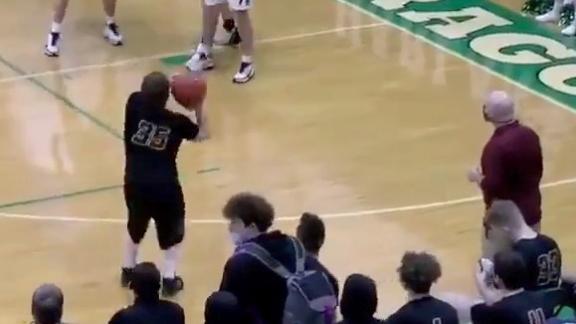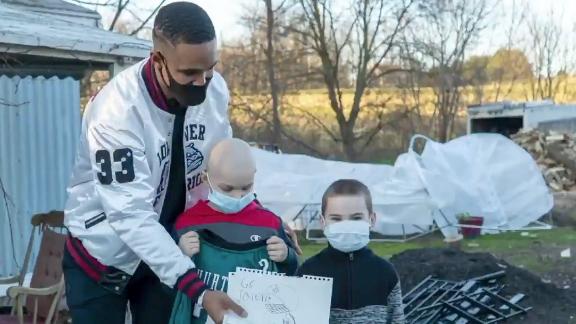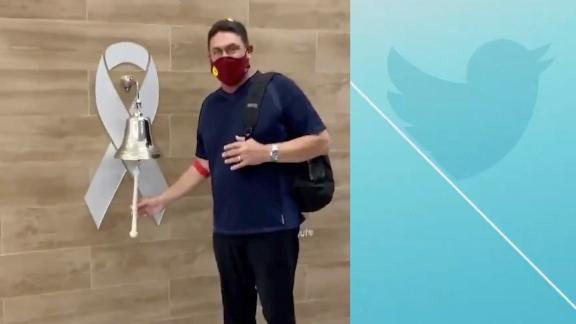Perhaps nobody in our sport is the face of college baseball more than Kyle Peterson, the ESPN color commentator and sideline reporter during the College World Series. Since 2003 he's been giving his two cents and million-dollar thoughts to ESPN's broadcasts of college games from the regionals to the CWS. This year, Kyle has joined the weekly Thursday night broadcasting booth to his list of duties. And our sport is all the better for it. I caught up with the former Stanford All-American and Omaha native after the Mississippi State-Ole Miss game he called in Oxford last Thursday.
ES: What has changed the most in college baseball since you pitched at Stanford in 1997?
KP: We were talking about this the other day on the air. The biggest change is probably just the amount of people that are paying attention to the sport. With the amount of money being put into new stadiums and the amount that athletic departments are putting into it, things are changing. It always seemed like people were saying, "We've got a baseball team, that's great. And if they win, that's great too." It wasn't that big of a deal. It seems like in the last 15 years, people are really paying attention to it because they realize you can make money from baseball now.
ES: What change have you seen with the new bats from a pitching perspective?
KP: I feel like before, you really had to pitch to miss the bat. You felt like you were really at risk anytime they would put the ball in play. Now, things are totally different, and I think you see a different approach from pitching coaches across the country. If you make a quality pitch and even if the guy puts it in play, the ball's not gonna go out of the yard. It might be a hit. Or it might hug the line for a double. But it's not like the guy's gonna hit the ball off- balance and still put it 10 rows into the left field stands anymore. And that's how it should be. If I hang a breaking ball and the guy puts a good swing on it, it should go out of the yard. But if I throw it in the right spot, very few guys have the ability to hit the ball out of the stadium. And that's the way it oughtta be.
ES: I remember you mentioning during one of the games I saw that the inside pitch is something a pitcher isn't afraid to throw anymore in college baseball.
xKP: Yeah, I think you're even more encouraged to throw it now. Before you were afraid to. The bats were so light and the sweet spot was so big, all guys had to do was get their hands to it. Now, it's not a wood bat, but it's close. And pitchers are starting to learn to pitch the way they need to in order to make it to pro ball. Now listen, this is still a college game and it should never be the same as the pro game, but now it's fair. At the beginning of the year I thought maybe they went too far in toning down the bats, but the more that I see it, I think they got it just right.
ES: What would you like to see changed in the game now?
KP: That's easy, the scholarships. The game should not be at a point where a kid can't play because he can't afford to go to a school. It's getting big enough, there are enough eyes on it, more schools are breaking even or making money off it. I realize a lot of programs are going away, but some are being brought back too. Oregon is a great example, they did it right. I mean, they didn't bring baseball back to lose money.
ES: Especially with the facilities they built there. No?
KP: And to me, that's the next step. That 11.7 scholarships isn't enough, I mean, it doesn't have to be 35 or something, but if we could get it to 15 or 16, that would be great and it would totally change the sport for the better.
ES: As for this season itself, who is the best team you've seen so far this year?
KP: Vanderbilt. Without a doubt. And it's nothing against anybody else. I think Florida is really good. I think South Carolina is really good.
ES: Have you seen Virginia yet?
KP: Not yet, but I know they're really good too. But of the teams I've actually seen, it's Vanderbilt. I will be really shocked if they don't make it to Omaha.
ES: The best player you've seen?
KP: To be honest with you, the guy I've been most impressed with is [South Carolina pitcher] Michael Roth. He's a guy that gets overlooked because he's not going to be a high draft pick. He doesn't throw 95. But his numbers are better than anybody else in the conference that is supposedly the best conference in the country. He beats everybody on a Friday night, and he does it left-handed throwing 85 miles an hour. Scouts might not like him the most, but he just wins.
ES: Who would you say is the most underrated coach in the country?
KP: Hmmm. That's a good one. I'll tell you the guy that gets a ton out of his players, and that's Ed Servais of Creighton. I think that the style that they play gets overlooked sometimes. They defend as well as anybody in the country every year, and I think that's the one thing you can point to as coaches in that who gets the most out of the least amount of talent. And that doesn't mean that Creighton doesn't have any talent, [because] they've got good talent. But it's not on par with the top clubs in the country, yet they'll defend and compete with just about anybody. So I think Ed Servais gets the most out of his players.
ES: When you go down to talk to a coach before working a game, what do you want to know more than anything else from him?
KP: If it's a team that I haven't seen, I want to go through the lineup and talk about everybody. It's not just, "Hey he hits .365 with seven home runs." My job is what is he working on? What's he good at? What's he not good at? What are we going to see from him? The only way to find that out is to watch them or to get the insight from the head coach. Then during the course of the game, I can bring some of those facts out or I have something to work from. I want to know all of their pitchers and what they have stuff-wise.
ES: You ask about every pitcher on the staff?
KP: Well, yes. I mean, especially the starter and anyone that we might see throw that day. And then a couple more. I ask about their speed, their stuff, their No. 1 pitch, their No. 2 pitch and their out- pitch. So I have an idea of what I want to talk about when they take the mound. When I first started doing this, I did too much research. Too much biographical stuff. My job is more to react to what I see on the field and to say why it happened. Back then, I was more worried about where they went to high school, which wasn't my job. Now I know better on how to prepare for a game.
Eric Sorenson, who runs College Baseball Today, and Walter Villa are regular contributors to ESPN's college baseball coverage. Follow Eric on Twitter: @stitch_head
Follow ESPN.com's college sports coverage on Twitter @ESPN_College and on Facebook.




